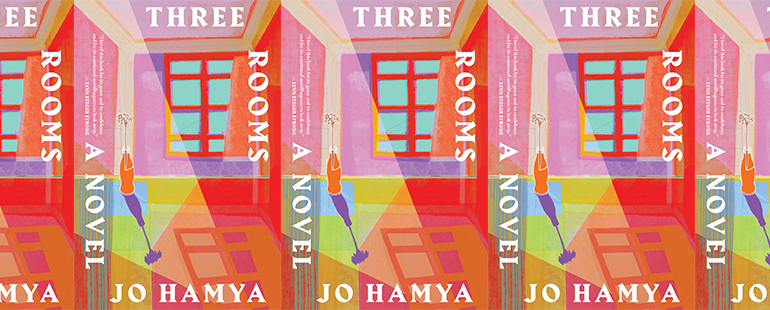Finding Oneself in Three Rooms

Three Rooms
Jo Hamya
Mariner Books | August 31, 2021
In her essay, “A Room of One’s Own,” Virginia Woolf posits that “A woman must have money and a room of her own if she is to write fiction.” Jo Hamya’s debut novel Three Rooms follows a woman who has no money and no room of her own, an all too familiar situation for many—as the narrator states early on, “the Department of National Statistics cited loss of rented accommodation as a key factor in the 4 percent yearly rise in homelessness.” The nameless millennial narrator who struggles to make ends meet and dreams of owning a flat in England is a relatable figure for those of us who have moved many times, and for whom homeownership is a distant dream.
The novel follows the narrator through three rooms: a room in a former grand home during a year-long post-doc position at Oxford, a living room within a friend of a friend’s flat during a stint as a temporary editor at a magazine, and finally, a room in her parents’ house, which she’s en-route to at the novel’s end. The displacement of inhabiting these new spaces is juxtaposed against virtual reality—the endless squares of Instagram photos, the inundation of tweets, the constant flow of news articles that keep her phone pinging. For this reason, the narrator’s journey is a relatively interior one: we learn about her through what news she’s reading, thinking about, and discussing.
The narrator constantly engages with what she encounters online, but this constant engagement comes with a price: she’s often anxious. Among peers, she feels herself assessed, as if experiencing the “react” and “respond” features of social media in real life. (This feeling is heightened by the fact no dialogue is rendered in quotation marks.) At the end of her post-doc, the narrator seems relatively unknown to her neighbors, and to Ghislane, a grad student whose life the narrator has been especially interested in. Ghislane, unlike the narrator, takes ownership of anything that comes into her orbit. While the narrator has attempted to make her room her own—“I had wanted to be able to recognize the smell of the room as mine, and so had stretched freshly laundered bedding over the radiator and draped it over the backs of chairs; kept Darjeeling out. I left books open everywhere”—the room is cleaned weekly by someone else. Her impact on the space, it seems, is weak and temporary.
Ghislane, in contrast, “well knew what an event was when it occurred and stood with admirable readiness to arrest it.” The narrator comes to this conclusion through what she sees of Ghislane on Instagram: “Now a gold quilted throw on the bed. A hook, dangling beads off a wall; the drawn curtains, decanted whiskey, and Dove deodorant aerosol. The box of Weetabix and the used bowl . . . The staged authenticity of the room. Ghislane called it, My true messy self.” Here, the novel ponders whether or not we can perpetuate a “true self” in online spaces. Is there enough room on the Internet to allow us to fully unfurl before the world, or is it as futile as trying to make a living space that belongs to someone else your own? The answer seems to lean toward futility. In their last in-person encounter, Ghislane says cuttingly to the narrator that among the academic crowd, “You look like them . . . You look right at home.” The narrator’s neighbor says the opposite: “Sometimes it was like you were acting out how you thought we’d all like you to be . . . You never went out. You never talked to anyone. You seemed to live on fairy meals, like boiled eggs and tangerines and honey. I could have read you in a novel.” Ghislane and the neighbor underscore the fact that being “at home” is not merely a spatial reality, but a way of being, a choice to make space for others.
The space of the narrator’s second room is smaller than her previous room. Renting a couch in an apartment for 80 pounds a month, she no longer has a room to herself—even the couch is not hers during the day. She must take her sheets off the couch each day so the owner can use it. The narrator wants to have a “real-world” job, but her editorial position at a London magazine and the casual contract she’s been given means job instability, and an inability to afford her own space. Her anxiety deepens, and she finds that though she has a place to stay, she doesn’t have a way to live. When the narrator is no longer needed by the magazine, she plans to return home to live with her parents, reinhabiting her childhood room. Right before she returns home, the narrator seeks solace in a museum where she comes to an important realization:
For the first time since I had had my own room in Oxford, walking through the gallery conferred a mode of solitude in which I could figure out what I thought, what made me, and how I arrived at the things I did. Because the room I was in did not belong to me, I could not do this infinitely. But for the moment I was in at least, I had the dignity and freedom of a sense of self which belonged entirely to me.
Here in this room that belongs to the public, the narrator discovers a sense of self. Though her life continues to be flooded by push notifications and photo memories from the year before, this moment is one of momentary breakthrough—one in which her prevailing loneliness breaks for a spell. The ending recalls the ending of Jhumpa Lahiri’s Whereabouts, which also features a nameless, anxious woman narrator on a train, left in a state of suspension between rooms and homes.
On the train, the narrator admits, “I had not found a job with which I could afford to put my life in one place, then nurture my relationship with family and friends.” What she does seem to find, however, is a renewed sense of selfhood. In an empty car on the train back home, the narrator relates, “All year there had been a sound rising in me, I had never said it right. I stood up and over the stained seats, the smeared windows, into the carriage, screamed—I.” The moment reminds me of the epigraph of E.M. Forster’s Howard’s End. Written 100 years before Hamya’s, it reads: “Only connect.” Hamya reveals the difficulties of connection in a highly technologized, highly competitive society. Though there is greater access to a wealth of information, how much more do we really know about the people around us? Perhaps there are other ways of being, this novel suggests. Perhaps there are other ways of seeing. Three Rooms is an invitation to reflect not only on where we house our bodies, but also our attention.


